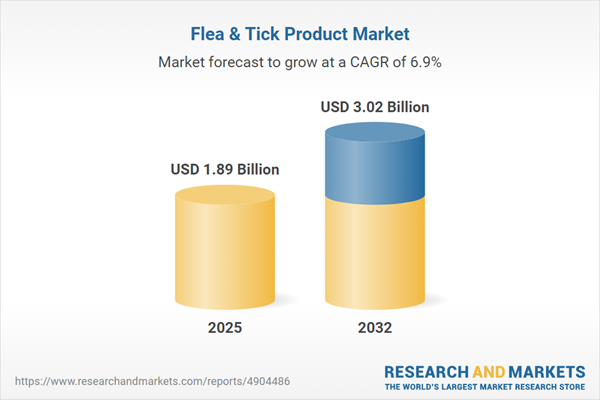Speak directly to the analyst to clarify any post sales queries you may have.
The flea and tick product market is positioned for significant transformation, shaped by shifting consumer expectations, evolving regulations, and rapid advances in formulation science. As pet health becomes increasingly prioritized, decision-makers require a clear understanding of the drivers influencing product innovation, competitive dynamics, and regional opportunities in this fast-evolving sector.
Market Snapshot: Flea and Tick Product Market Growth Outlook
The Flea & Tick Product Market grew from USD 1.77 billion in 2024 to USD 1.89 billion in 2025. It is expected to continue growing at a CAGR of 6.91%, reaching USD 3.02 billion by 2032. Demand is driven by enhanced pet ownership trends, increasing awareness of animal health, and advances in product design that address both safety and convenience. Consumer expectations are evolving, with a growing preference for products that merge efficacy with simplicity, while manufacturers and distributors face higher standards for regulatory compliance and sustainability.
Scope & Segmentation of the Flea and Tick Product Market
This analysis offers a comprehensive view of the sector, detailing key segments, target animal types, distribution channels, regional markets, and technological advances. The study ensures strategic breadth by focusing on the following:
- Product Types: Collar, Oral (Chewable and Tablet), Shampoo & Dip, Spot-On, Spray
- Animal Types: Cat, Dog
- Distribution Channels: Offline, Online
- Regions: Americas (United States, Canada, Mexico, Brazil, Argentina, Chile, Colombia, Peru), Europe (United Kingdom, Germany, France, Russia, Italy, Spain, Netherlands, Sweden, Poland, Switzerland), Middle East (United Arab Emirates, Saudi Arabia, Qatar, Turkey, Israel), Africa (South Africa, Nigeria, Egypt, Kenya), Asia-Pacific (China, India, Japan, Australia, South Korea, Indonesia, Thailand, Malaysia, Singapore, Taiwan)
- Key Companies: Zoetis Inc., Elanco Animal Health Incorporated, Merck & Co., Boehringer Ingelheim International GmbH, Ceva Santé Animale S.A., Virbac S.A., Vetoquinol S.A., Dechra Pharmaceuticals PLC, Norbrook Laboratories Limited, Sogeval S.A.
Key Takeaways for Senior Decision Makers
- Consumers increasingly value convenient, multi-format solutions, prompting manufacturers to innovate across collars, oral treatments, spot-on formulations, and more.
- Regulatory scrutiny has become more intensive, compelling established industry players to pursue reformulation and eco-friendlier alternatives, especially amid rising environmental and safety standards.
- Digital transformation, including telehealth and e-commerce platforms, is changing how products reach end users and how efficacy is monitored, prompting both incumbents and new entrants to expand direct-to-consumer strategies.
- The competitive environment is being shaped by both large multinationals with broad portfolios and agile mid-tier specialists targeting high-margin and niche segments.
- Emerging trends, such as pet humanization and rising online veterinary consultation rates, are influencing not just product formats but also marketing and channel strategies.
Tariff Impact: Navigating Cost and Supply Chain Pressures in 2025
Recent U.S. tariff adjustments have introduced fresh challenges for supply chain stability and procurement strategies in flea and tick treatments. Companies face higher input costs, extended lead times for specialty ingredients, and are responding by diversifying supplier bases and implementing new inventory management practices. This dynamic is prompting streamlining of product portfolios and a renewed focus on operational agility and pricing strategy resilience, especially for firms with limited supplier leverage.
Methodology & Data Sources
This market analysis draws on both primary interviews with veterinarians, scientists, and senior executives, and secondary research from industry journals, white papers, and patent databases. Cross-referencing and expert validation strengthen alignment with evolving industry forces, ensuring that projections and insights reflect both supportable data and nuanced market realities.
Why This Report Matters for Business Leaders
- Empowers strategy teams to benchmark against leading global and regional players, and to identify high-growth product and channel opportunities.
- Provides actionable, data-driven guidance to optimize R&D, regulatory, and sourcing investments in response to the parallel challenges of innovation demand and cost management.
Conclusion
This report provides a strategic blueprint for decision-makers navigating the complex flea and tick product landscape. By aligning insights with actionable recommendations, it supports innovation, operational resilience, and market leadership in the face of ongoing market volatility and regulatory change.
Additional Product Information:
- Purchase of this report includes 1 year online access with quarterly updates.
- This report can be updated on request. Please contact our Customer Experience team using the Ask a Question widget on our website.
Table of Contents
3. Executive Summary
4. Market Overview
7. Cumulative Impact of Artificial Intelligence 2025
Companies Mentioned
The companies profiled in this Flea & Tick Product market report include:- Zoetis Inc.
- Elanco Animal Health Incorporated
- Merck & Co., Inc.
- Boehringer Ingelheim International GmbH
- Ceva Santé Animale S.A.
- Virbac S.A.
- Vetoquinol S.A.
- Dechra Pharmaceuticals PLC
- Norbrook Laboratories Limited
- Sogeval S.A.
Table Information
| Report Attribute | Details |
|---|---|
| No. of Pages | 195 |
| Published | October 2025 |
| Forecast Period | 2025 - 2032 |
| Estimated Market Value ( USD | $ 1.89 Billion |
| Forecasted Market Value ( USD | $ 3.02 Billion |
| Compound Annual Growth Rate | 6.9% |
| Regions Covered | Global |
| No. of Companies Mentioned | 11 |









